Analysis of Depression: Mental Health Condition in United Kingdom
VerifiedAdded on 2023/06/14
|17
|5235
|389
Essay
AI Summary
This essay provides a detailed overview of depression as a mental health condition in the United Kingdom. It covers the definition, diagnostic criteria, signs, and symptoms of depression, along with its epidemiology, including causation, prevalence, co-morbidity, and prognosis. The essay further discusses recovery and prevention strategies, treatment and intervention methods, and the impact of depression on individual service users, their families, and healthcare professionals. It also includes a critical analysis of clinical practice and theories related to depression, referencing recent clinical guidelines and research policies to ensure safe practice.
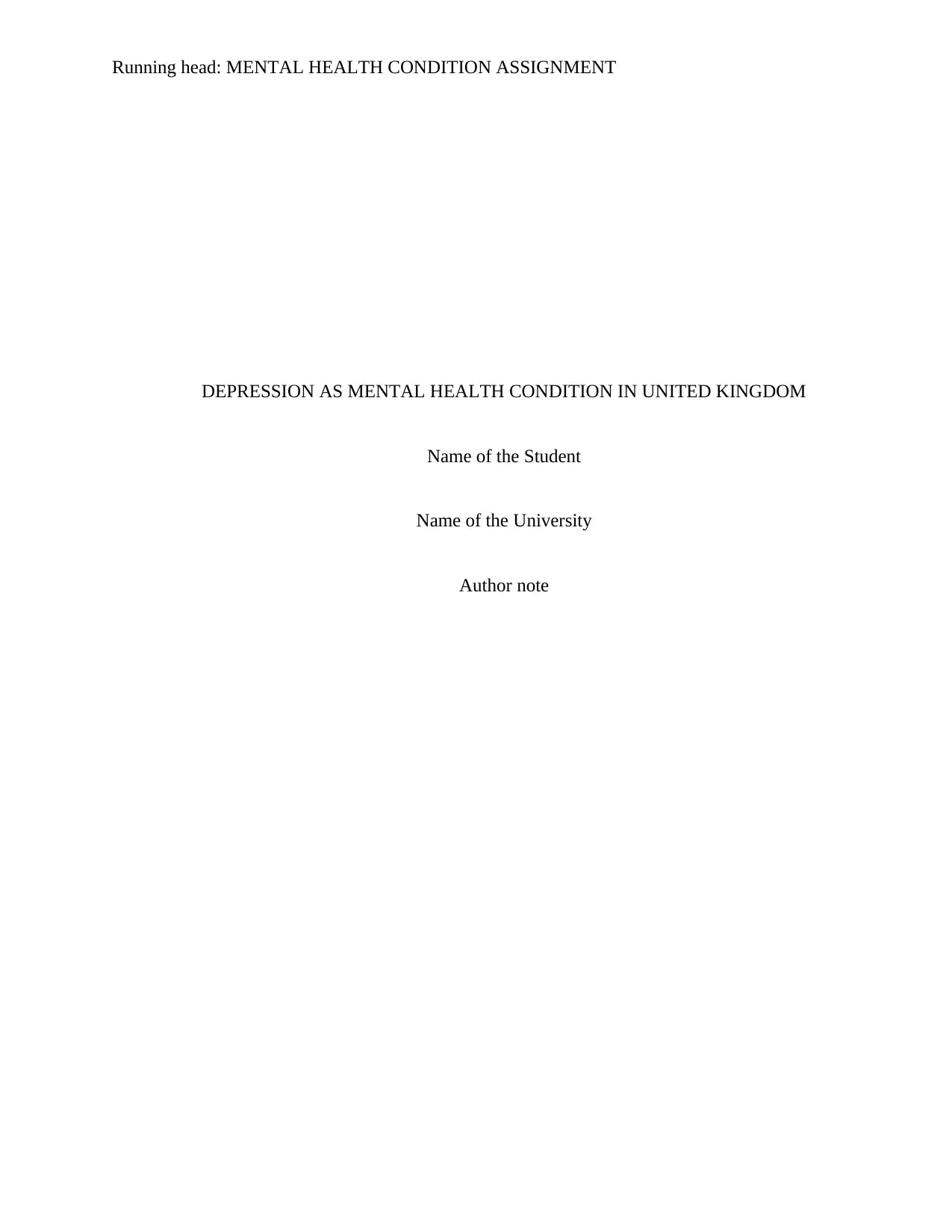
Running head: MENTAL HEALTH CONDITION ASSIGNMENT
DEPRESSION AS MENTAL HEALTH CONDITION IN UNITED KINGDOM
Name of the Student
Name of the University
Author note
DEPRESSION AS MENTAL HEALTH CONDITION IN UNITED KINGDOM
Name of the Student
Name of the University
Author note
Paraphrase This Document
Need a fresh take? Get an instant paraphrase of this document with our AI Paraphraser
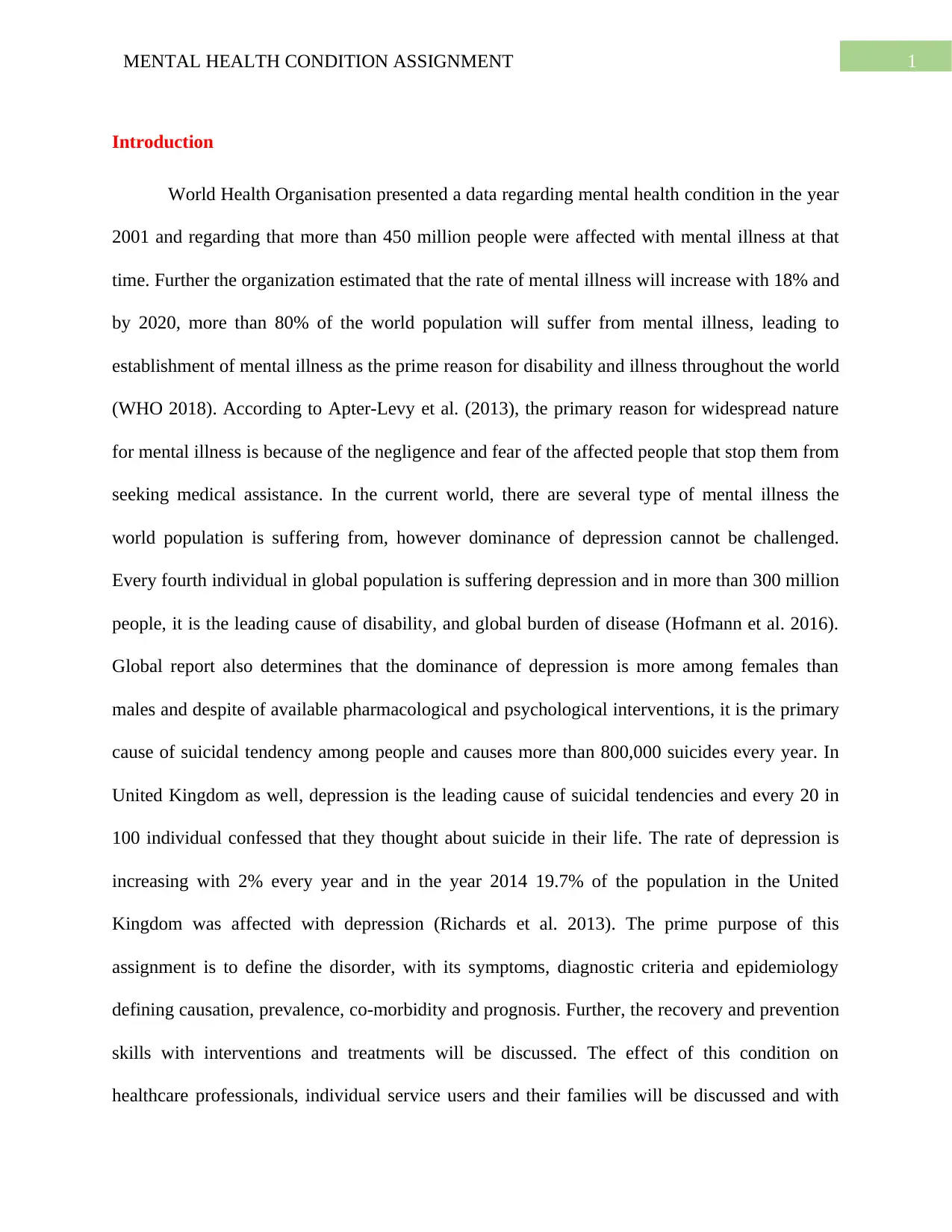
1MENTAL HEALTH CONDITION ASSIGNMENT
Introduction
World Health Organisation presented a data regarding mental health condition in the year
2001 and regarding that more than 450 million people were affected with mental illness at that
time. Further the organization estimated that the rate of mental illness will increase with 18% and
by 2020, more than 80% of the world population will suffer from mental illness, leading to
establishment of mental illness as the prime reason for disability and illness throughout the world
(WHO 2018). According to Apter-Levy et al. (2013), the primary reason for widespread nature
for mental illness is because of the negligence and fear of the affected people that stop them from
seeking medical assistance. In the current world, there are several type of mental illness the
world population is suffering from, however dominance of depression cannot be challenged.
Every fourth individual in global population is suffering depression and in more than 300 million
people, it is the leading cause of disability, and global burden of disease (Hofmann et al. 2016).
Global report also determines that the dominance of depression is more among females than
males and despite of available pharmacological and psychological interventions, it is the primary
cause of suicidal tendency among people and causes more than 800,000 suicides every year. In
United Kingdom as well, depression is the leading cause of suicidal tendencies and every 20 in
100 individual confessed that they thought about suicide in their life. The rate of depression is
increasing with 2% every year and in the year 2014 19.7% of the population in the United
Kingdom was affected with depression (Richards et al. 2013). The prime purpose of this
assignment is to define the disorder, with its symptoms, diagnostic criteria and epidemiology
defining causation, prevalence, co-morbidity and prognosis. Further, the recovery and prevention
skills with interventions and treatments will be discussed. The effect of this condition on
healthcare professionals, individual service users and their families will be discussed and with
Introduction
World Health Organisation presented a data regarding mental health condition in the year
2001 and regarding that more than 450 million people were affected with mental illness at that
time. Further the organization estimated that the rate of mental illness will increase with 18% and
by 2020, more than 80% of the world population will suffer from mental illness, leading to
establishment of mental illness as the prime reason for disability and illness throughout the world
(WHO 2018). According to Apter-Levy et al. (2013), the primary reason for widespread nature
for mental illness is because of the negligence and fear of the affected people that stop them from
seeking medical assistance. In the current world, there are several type of mental illness the
world population is suffering from, however dominance of depression cannot be challenged.
Every fourth individual in global population is suffering depression and in more than 300 million
people, it is the leading cause of disability, and global burden of disease (Hofmann et al. 2016).
Global report also determines that the dominance of depression is more among females than
males and despite of available pharmacological and psychological interventions, it is the primary
cause of suicidal tendency among people and causes more than 800,000 suicides every year. In
United Kingdom as well, depression is the leading cause of suicidal tendencies and every 20 in
100 individual confessed that they thought about suicide in their life. The rate of depression is
increasing with 2% every year and in the year 2014 19.7% of the population in the United
Kingdom was affected with depression (Richards et al. 2013). The prime purpose of this
assignment is to define the disorder, with its symptoms, diagnostic criteria and epidemiology
defining causation, prevalence, co-morbidity and prognosis. Further, the recovery and prevention
skills with interventions and treatments will be discussed. The effect of this condition on
healthcare professionals, individual service users and their families will be discussed and with
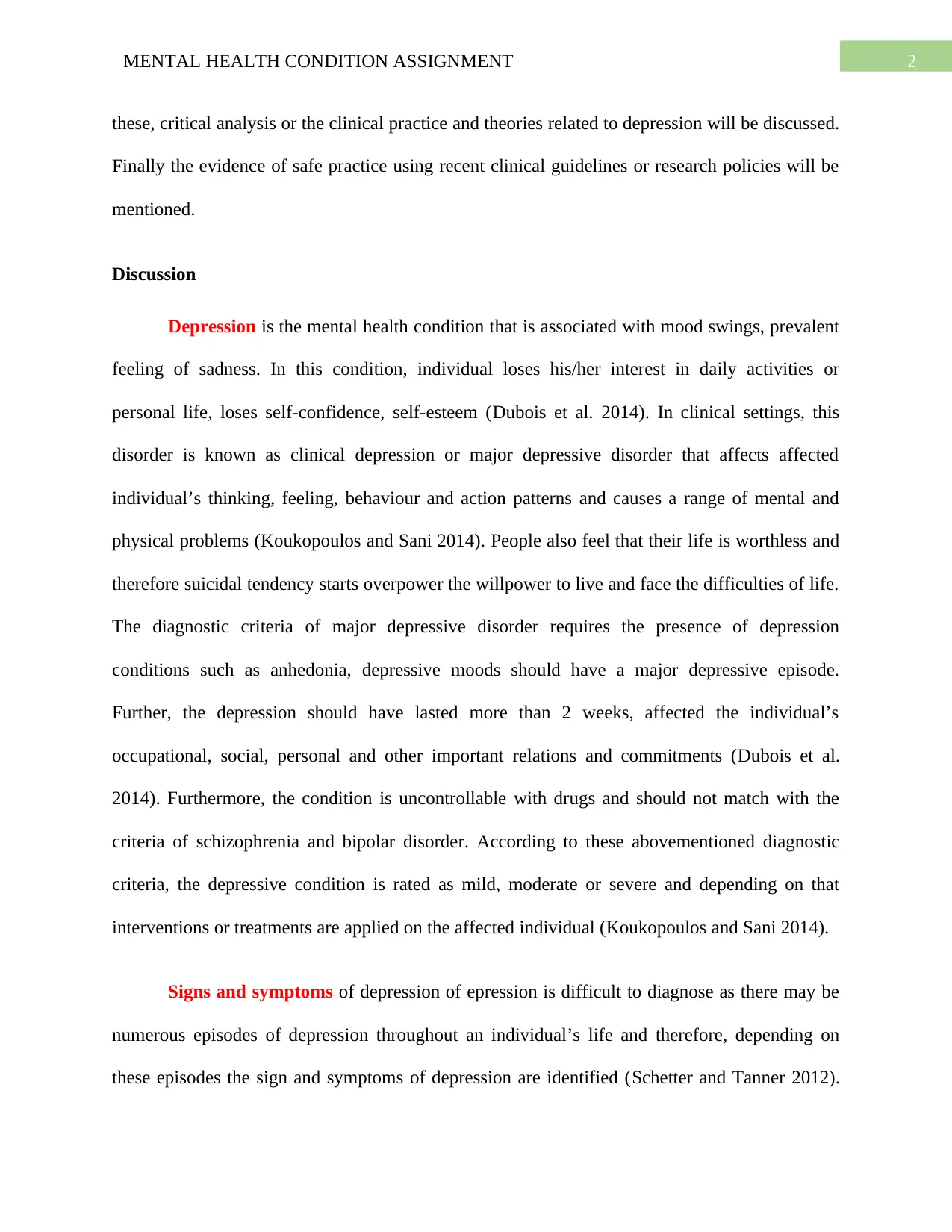
2MENTAL HEALTH CONDITION ASSIGNMENT
these, critical analysis or the clinical practice and theories related to depression will be discussed.
Finally the evidence of safe practice using recent clinical guidelines or research policies will be
mentioned.
Discussion
Depression is the mental health condition that is associated with mood swings, prevalent
feeling of sadness. In this condition, individual loses his/her interest in daily activities or
personal life, loses self-confidence, self-esteem (Dubois et al. 2014). In clinical settings, this
disorder is known as clinical depression or major depressive disorder that affects affected
individual’s thinking, feeling, behaviour and action patterns and causes a range of mental and
physical problems (Koukopoulos and Sani 2014). People also feel that their life is worthless and
therefore suicidal tendency starts overpower the willpower to live and face the difficulties of life.
The diagnostic criteria of major depressive disorder requires the presence of depression
conditions such as anhedonia, depressive moods should have a major depressive episode.
Further, the depression should have lasted more than 2 weeks, affected the individual’s
occupational, social, personal and other important relations and commitments (Dubois et al.
2014). Furthermore, the condition is uncontrollable with drugs and should not match with the
criteria of schizophrenia and bipolar disorder. According to these abovementioned diagnostic
criteria, the depressive condition is rated as mild, moderate or severe and depending on that
interventions or treatments are applied on the affected individual (Koukopoulos and Sani 2014).
Signs and symptoms of depression of epression is difficult to diagnose as there may be
numerous episodes of depression throughout an individual’s life and therefore, depending on
these episodes the sign and symptoms of depression are identified (Schetter and Tanner 2012).
these, critical analysis or the clinical practice and theories related to depression will be discussed.
Finally the evidence of safe practice using recent clinical guidelines or research policies will be
mentioned.
Discussion
Depression is the mental health condition that is associated with mood swings, prevalent
feeling of sadness. In this condition, individual loses his/her interest in daily activities or
personal life, loses self-confidence, self-esteem (Dubois et al. 2014). In clinical settings, this
disorder is known as clinical depression or major depressive disorder that affects affected
individual’s thinking, feeling, behaviour and action patterns and causes a range of mental and
physical problems (Koukopoulos and Sani 2014). People also feel that their life is worthless and
therefore suicidal tendency starts overpower the willpower to live and face the difficulties of life.
The diagnostic criteria of major depressive disorder requires the presence of depression
conditions such as anhedonia, depressive moods should have a major depressive episode.
Further, the depression should have lasted more than 2 weeks, affected the individual’s
occupational, social, personal and other important relations and commitments (Dubois et al.
2014). Furthermore, the condition is uncontrollable with drugs and should not match with the
criteria of schizophrenia and bipolar disorder. According to these abovementioned diagnostic
criteria, the depressive condition is rated as mild, moderate or severe and depending on that
interventions or treatments are applied on the affected individual (Koukopoulos and Sani 2014).
Signs and symptoms of depression of epression is difficult to diagnose as there may be
numerous episodes of depression throughout an individual’s life and therefore, depending on
these episodes the sign and symptoms of depression are identified (Schetter and Tanner 2012).
⊘ This is a preview!⊘
Do you want full access?
Subscribe today to unlock all pages.

Trusted by 1+ million students worldwide
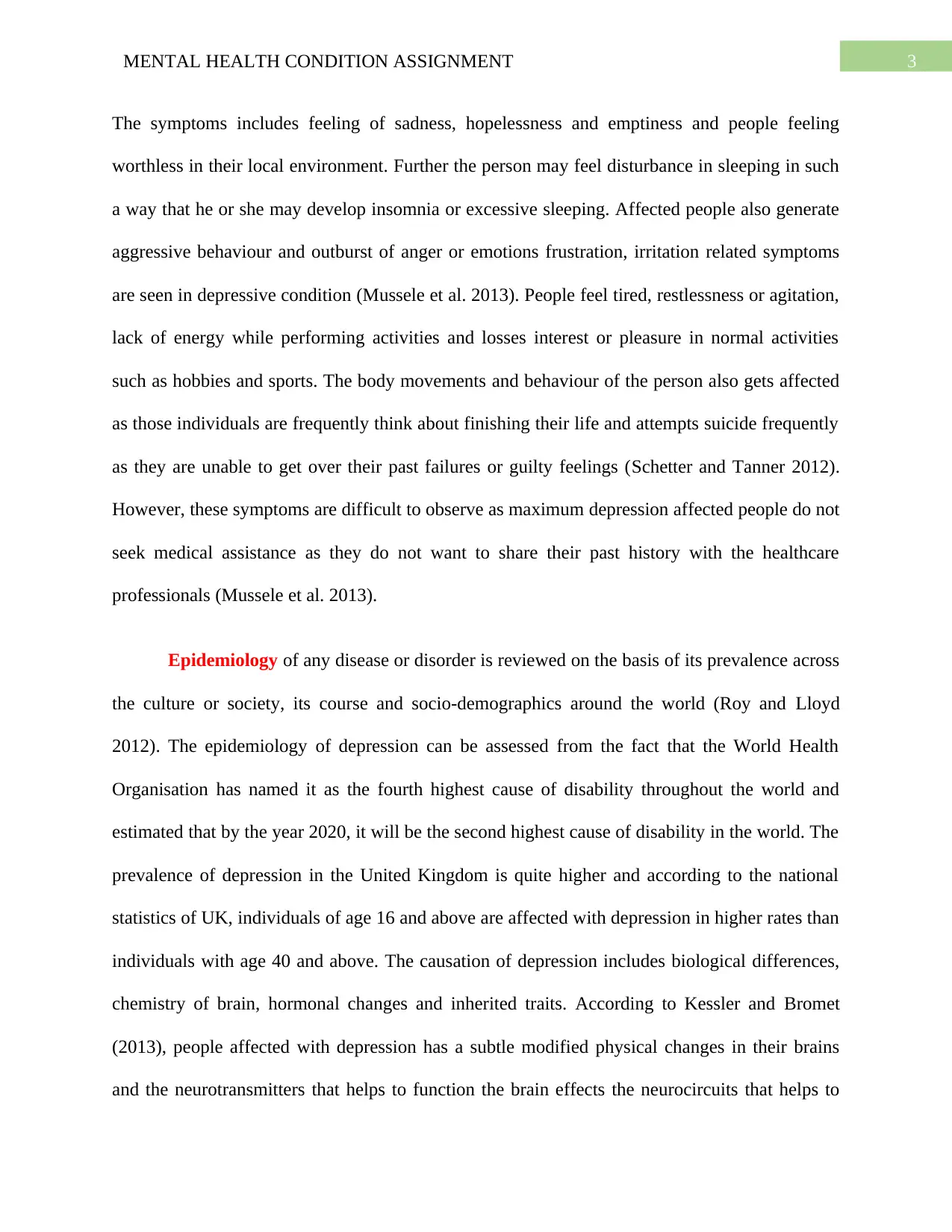
3MENTAL HEALTH CONDITION ASSIGNMENT
The symptoms includes feeling of sadness, hopelessness and emptiness and people feeling
worthless in their local environment. Further the person may feel disturbance in sleeping in such
a way that he or she may develop insomnia or excessive sleeping. Affected people also generate
aggressive behaviour and outburst of anger or emotions frustration, irritation related symptoms
are seen in depressive condition (Mussele et al. 2013). People feel tired, restlessness or agitation,
lack of energy while performing activities and losses interest or pleasure in normal activities
such as hobbies and sports. The body movements and behaviour of the person also gets affected
as those individuals are frequently think about finishing their life and attempts suicide frequently
as they are unable to get over their past failures or guilty feelings (Schetter and Tanner 2012).
However, these symptoms are difficult to observe as maximum depression affected people do not
seek medical assistance as they do not want to share their past history with the healthcare
professionals (Mussele et al. 2013).
Epidemiology of any disease or disorder is reviewed on the basis of its prevalence across
the culture or society, its course and socio-demographics around the world (Roy and Lloyd
2012). The epidemiology of depression can be assessed from the fact that the World Health
Organisation has named it as the fourth highest cause of disability throughout the world and
estimated that by the year 2020, it will be the second highest cause of disability in the world. The
prevalence of depression in the United Kingdom is quite higher and according to the national
statistics of UK, individuals of age 16 and above are affected with depression in higher rates than
individuals with age 40 and above. The causation of depression includes biological differences,
chemistry of brain, hormonal changes and inherited traits. According to Kessler and Bromet
(2013), people affected with depression has a subtle modified physical changes in their brains
and the neurotransmitters that helps to function the brain effects the neurocircuits that helps to
The symptoms includes feeling of sadness, hopelessness and emptiness and people feeling
worthless in their local environment. Further the person may feel disturbance in sleeping in such
a way that he or she may develop insomnia or excessive sleeping. Affected people also generate
aggressive behaviour and outburst of anger or emotions frustration, irritation related symptoms
are seen in depressive condition (Mussele et al. 2013). People feel tired, restlessness or agitation,
lack of energy while performing activities and losses interest or pleasure in normal activities
such as hobbies and sports. The body movements and behaviour of the person also gets affected
as those individuals are frequently think about finishing their life and attempts suicide frequently
as they are unable to get over their past failures or guilty feelings (Schetter and Tanner 2012).
However, these symptoms are difficult to observe as maximum depression affected people do not
seek medical assistance as they do not want to share their past history with the healthcare
professionals (Mussele et al. 2013).
Epidemiology of any disease or disorder is reviewed on the basis of its prevalence across
the culture or society, its course and socio-demographics around the world (Roy and Lloyd
2012). The epidemiology of depression can be assessed from the fact that the World Health
Organisation has named it as the fourth highest cause of disability throughout the world and
estimated that by the year 2020, it will be the second highest cause of disability in the world. The
prevalence of depression in the United Kingdom is quite higher and according to the national
statistics of UK, individuals of age 16 and above are affected with depression in higher rates than
individuals with age 40 and above. The causation of depression includes biological differences,
chemistry of brain, hormonal changes and inherited traits. According to Kessler and Bromet
(2013), people affected with depression has a subtle modified physical changes in their brains
and the neurotransmitters that helps to function the brain effects the neurocircuits that helps to
Paraphrase This Document
Need a fresh take? Get an instant paraphrase of this document with our AI Paraphraser
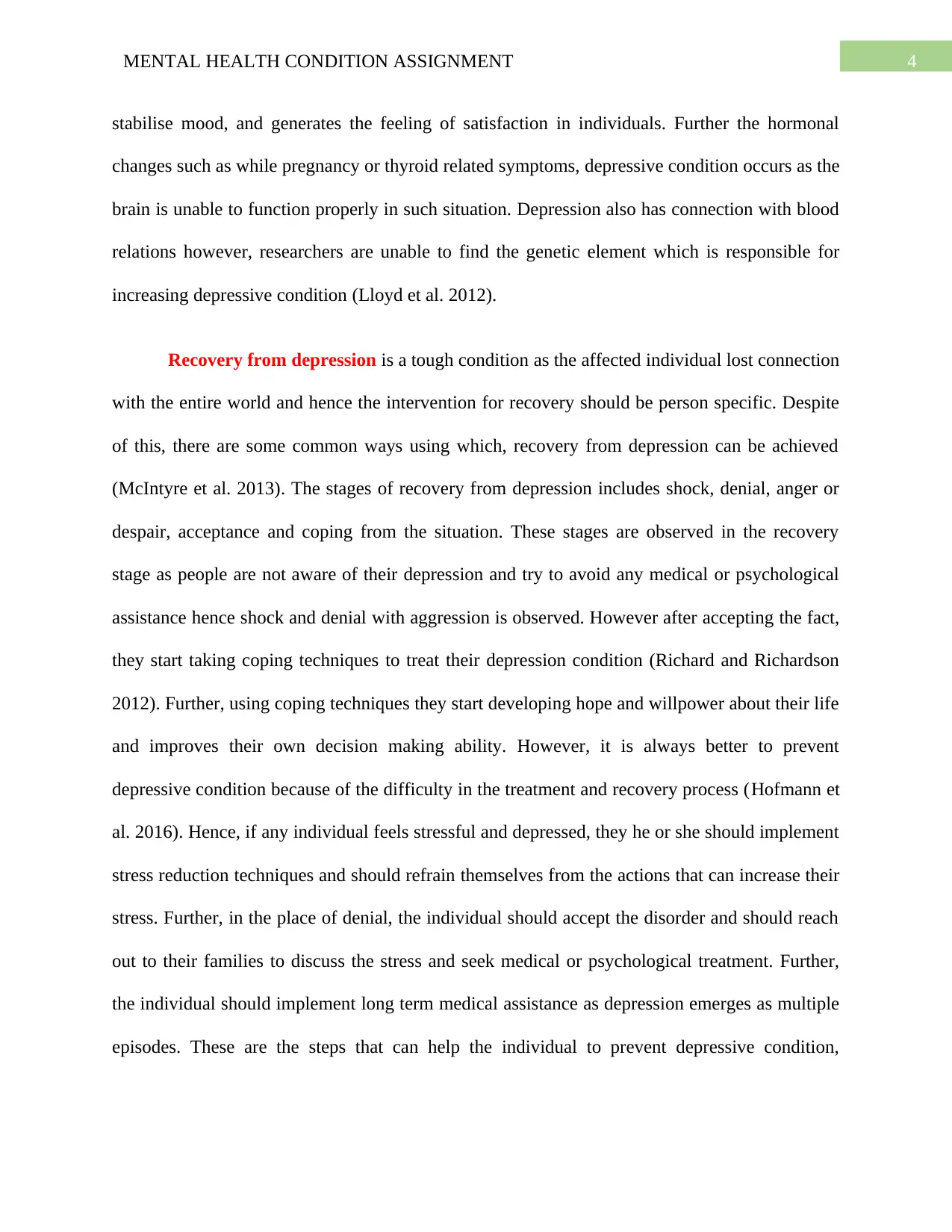
4MENTAL HEALTH CONDITION ASSIGNMENT
stabilise mood, and generates the feeling of satisfaction in individuals. Further the hormonal
changes such as while pregnancy or thyroid related symptoms, depressive condition occurs as the
brain is unable to function properly in such situation. Depression also has connection with blood
relations however, researchers are unable to find the genetic element which is responsible for
increasing depressive condition (Lloyd et al. 2012).
Recovery from depression is a tough condition as the affected individual lost connection
with the entire world and hence the intervention for recovery should be person specific. Despite
of this, there are some common ways using which, recovery from depression can be achieved
(McIntyre et al. 2013). The stages of recovery from depression includes shock, denial, anger or
despair, acceptance and coping from the situation. These stages are observed in the recovery
stage as people are not aware of their depression and try to avoid any medical or psychological
assistance hence shock and denial with aggression is observed. However after accepting the fact,
they start taking coping techniques to treat their depression condition (Richard and Richardson
2012). Further, using coping techniques they start developing hope and willpower about their life
and improves their own decision making ability. However, it is always better to prevent
depressive condition because of the difficulty in the treatment and recovery process (Hofmann et
al. 2016). Hence, if any individual feels stressful and depressed, they he or she should implement
stress reduction techniques and should refrain themselves from the actions that can increase their
stress. Further, in the place of denial, the individual should accept the disorder and should reach
out to their families to discuss the stress and seek medical or psychological treatment. Further,
the individual should implement long term medical assistance as depression emerges as multiple
episodes. These are the steps that can help the individual to prevent depressive condition,
stabilise mood, and generates the feeling of satisfaction in individuals. Further the hormonal
changes such as while pregnancy or thyroid related symptoms, depressive condition occurs as the
brain is unable to function properly in such situation. Depression also has connection with blood
relations however, researchers are unable to find the genetic element which is responsible for
increasing depressive condition (Lloyd et al. 2012).
Recovery from depression is a tough condition as the affected individual lost connection
with the entire world and hence the intervention for recovery should be person specific. Despite
of this, there are some common ways using which, recovery from depression can be achieved
(McIntyre et al. 2013). The stages of recovery from depression includes shock, denial, anger or
despair, acceptance and coping from the situation. These stages are observed in the recovery
stage as people are not aware of their depression and try to avoid any medical or psychological
assistance hence shock and denial with aggression is observed. However after accepting the fact,
they start taking coping techniques to treat their depression condition (Richard and Richardson
2012). Further, using coping techniques they start developing hope and willpower about their life
and improves their own decision making ability. However, it is always better to prevent
depressive condition because of the difficulty in the treatment and recovery process (Hofmann et
al. 2016). Hence, if any individual feels stressful and depressed, they he or she should implement
stress reduction techniques and should refrain themselves from the actions that can increase their
stress. Further, in the place of denial, the individual should accept the disorder and should reach
out to their families to discuss the stress and seek medical or psychological treatment. Further,
the individual should implement long term medical assistance as depression emerges as multiple
episodes. These are the steps that can help the individual to prevent depressive condition,
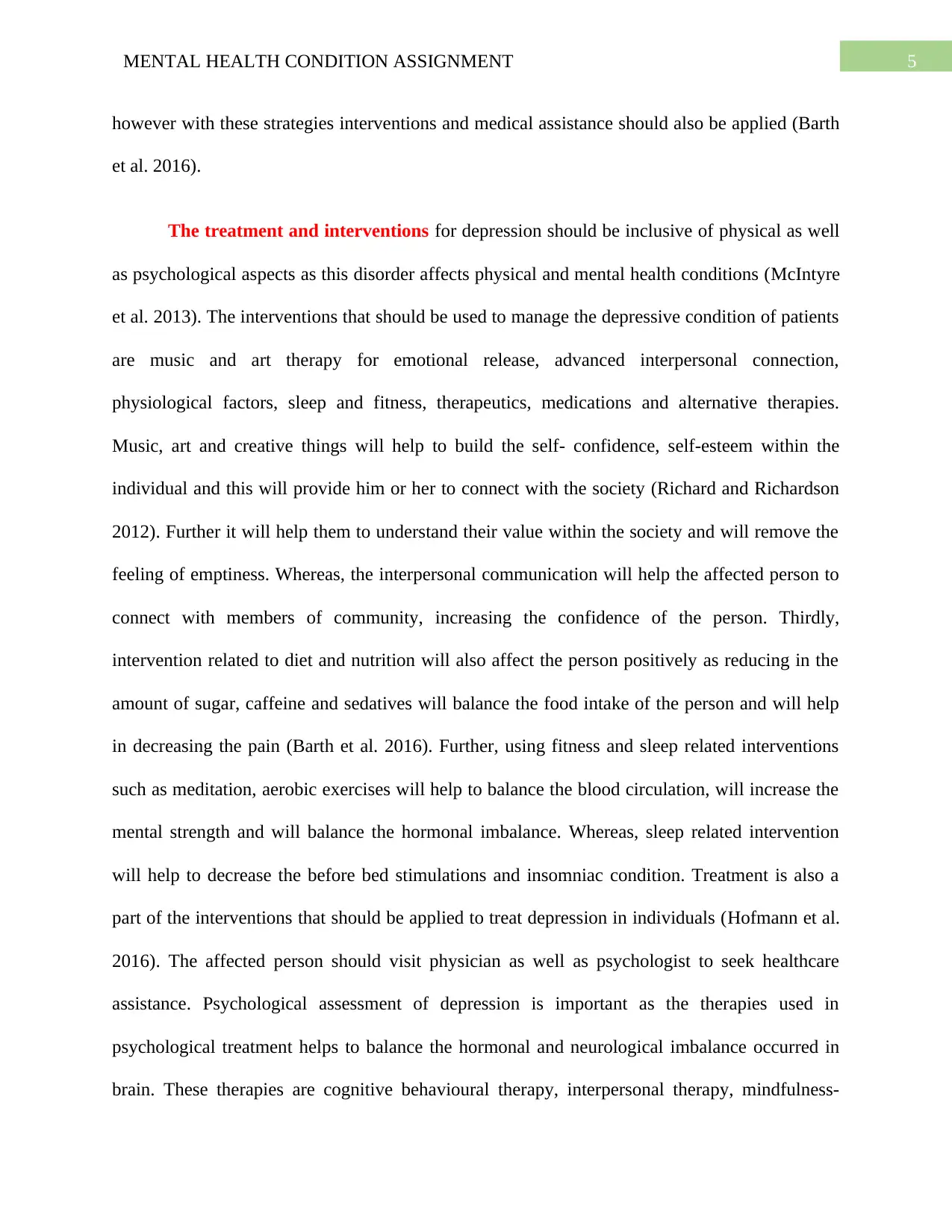
5MENTAL HEALTH CONDITION ASSIGNMENT
however with these strategies interventions and medical assistance should also be applied (Barth
et al. 2016).
The treatment and interventions for depression should be inclusive of physical as well
as psychological aspects as this disorder affects physical and mental health conditions (McIntyre
et al. 2013). The interventions that should be used to manage the depressive condition of patients
are music and art therapy for emotional release, advanced interpersonal connection,
physiological factors, sleep and fitness, therapeutics, medications and alternative therapies.
Music, art and creative things will help to build the self- confidence, self-esteem within the
individual and this will provide him or her to connect with the society (Richard and Richardson
2012). Further it will help them to understand their value within the society and will remove the
feeling of emptiness. Whereas, the interpersonal communication will help the affected person to
connect with members of community, increasing the confidence of the person. Thirdly,
intervention related to diet and nutrition will also affect the person positively as reducing in the
amount of sugar, caffeine and sedatives will balance the food intake of the person and will help
in decreasing the pain (Barth et al. 2016). Further, using fitness and sleep related interventions
such as meditation, aerobic exercises will help to balance the blood circulation, will increase the
mental strength and will balance the hormonal imbalance. Whereas, sleep related intervention
will help to decrease the before bed stimulations and insomniac condition. Treatment is also a
part of the interventions that should be applied to treat depression in individuals (Hofmann et al.
2016). The affected person should visit physician as well as psychologist to seek healthcare
assistance. Psychological assessment of depression is important as the therapies used in
psychological treatment helps to balance the hormonal and neurological imbalance occurred in
brain. These therapies are cognitive behavioural therapy, interpersonal therapy, mindfulness-
however with these strategies interventions and medical assistance should also be applied (Barth
et al. 2016).
The treatment and interventions for depression should be inclusive of physical as well
as psychological aspects as this disorder affects physical and mental health conditions (McIntyre
et al. 2013). The interventions that should be used to manage the depressive condition of patients
are music and art therapy for emotional release, advanced interpersonal connection,
physiological factors, sleep and fitness, therapeutics, medications and alternative therapies.
Music, art and creative things will help to build the self- confidence, self-esteem within the
individual and this will provide him or her to connect with the society (Richard and Richardson
2012). Further it will help them to understand their value within the society and will remove the
feeling of emptiness. Whereas, the interpersonal communication will help the affected person to
connect with members of community, increasing the confidence of the person. Thirdly,
intervention related to diet and nutrition will also affect the person positively as reducing in the
amount of sugar, caffeine and sedatives will balance the food intake of the person and will help
in decreasing the pain (Barth et al. 2016). Further, using fitness and sleep related interventions
such as meditation, aerobic exercises will help to balance the blood circulation, will increase the
mental strength and will balance the hormonal imbalance. Whereas, sleep related intervention
will help to decrease the before bed stimulations and insomniac condition. Treatment is also a
part of the interventions that should be applied to treat depression in individuals (Hofmann et al.
2016). The affected person should visit physician as well as psychologist to seek healthcare
assistance. Psychological assessment of depression is important as the therapies used in
psychological treatment helps to balance the hormonal and neurological imbalance occurred in
brain. These therapies are cognitive behavioural therapy, interpersonal therapy, mindfulness-
⊘ This is a preview!⊘
Do you want full access?
Subscribe today to unlock all pages.

Trusted by 1+ million students worldwide
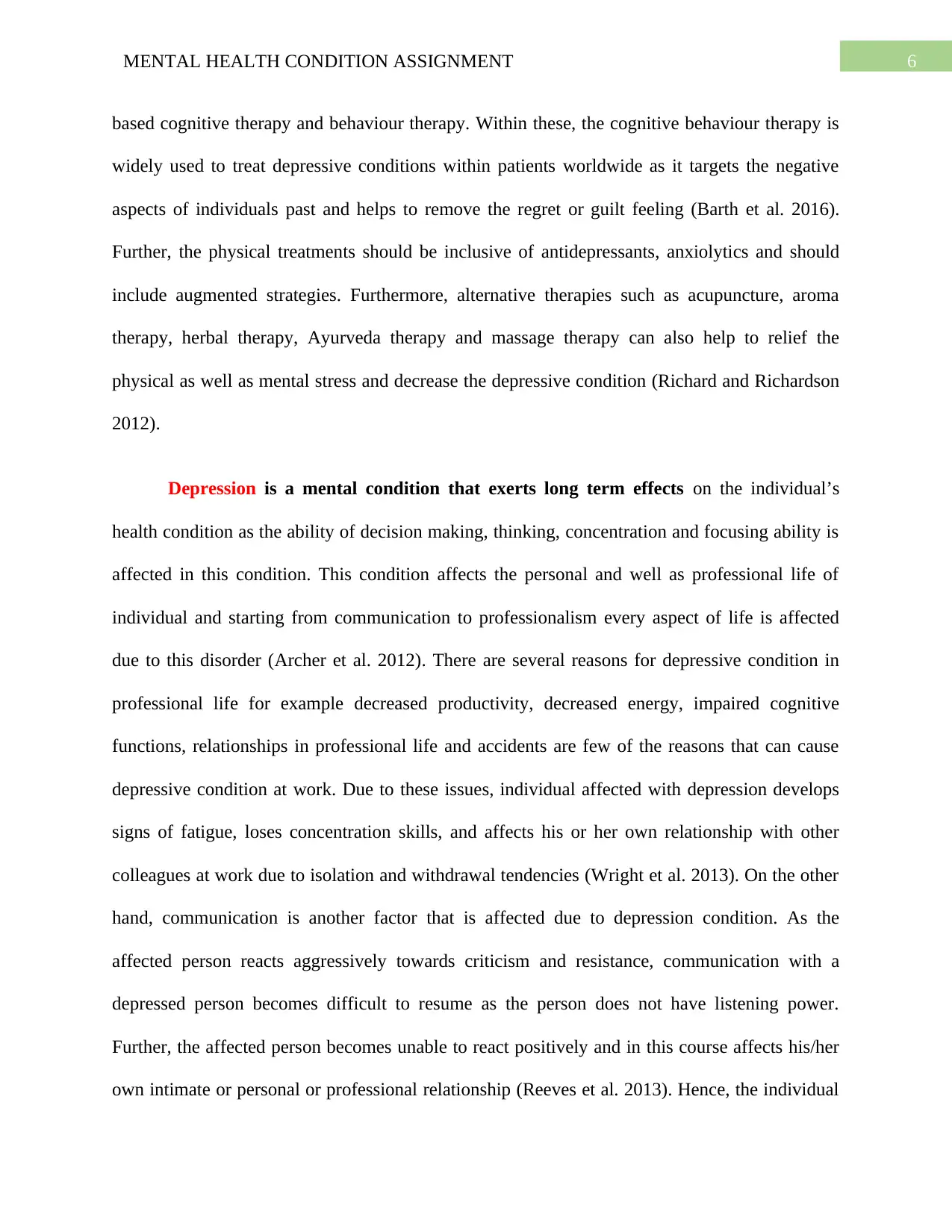
6MENTAL HEALTH CONDITION ASSIGNMENT
based cognitive therapy and behaviour therapy. Within these, the cognitive behaviour therapy is
widely used to treat depressive conditions within patients worldwide as it targets the negative
aspects of individuals past and helps to remove the regret or guilt feeling (Barth et al. 2016).
Further, the physical treatments should be inclusive of antidepressants, anxiolytics and should
include augmented strategies. Furthermore, alternative therapies such as acupuncture, aroma
therapy, herbal therapy, Ayurveda therapy and massage therapy can also help to relief the
physical as well as mental stress and decrease the depressive condition (Richard and Richardson
2012).
Depression is a mental condition that exerts long term effects on the individual’s
health condition as the ability of decision making, thinking, concentration and focusing ability is
affected in this condition. This condition affects the personal and well as professional life of
individual and starting from communication to professionalism every aspect of life is affected
due to this disorder (Archer et al. 2012). There are several reasons for depressive condition in
professional life for example decreased productivity, decreased energy, impaired cognitive
functions, relationships in professional life and accidents are few of the reasons that can cause
depressive condition at work. Due to these issues, individual affected with depression develops
signs of fatigue, loses concentration skills, and affects his or her own relationship with other
colleagues at work due to isolation and withdrawal tendencies (Wright et al. 2013). On the other
hand, communication is another factor that is affected due to depression condition. As the
affected person reacts aggressively towards criticism and resistance, communication with a
depressed person becomes difficult to resume as the person does not have listening power.
Further, the affected person becomes unable to react positively and in this course affects his/her
own intimate or personal or professional relationship (Reeves et al. 2013). Hence, the individual
based cognitive therapy and behaviour therapy. Within these, the cognitive behaviour therapy is
widely used to treat depressive conditions within patients worldwide as it targets the negative
aspects of individuals past and helps to remove the regret or guilt feeling (Barth et al. 2016).
Further, the physical treatments should be inclusive of antidepressants, anxiolytics and should
include augmented strategies. Furthermore, alternative therapies such as acupuncture, aroma
therapy, herbal therapy, Ayurveda therapy and massage therapy can also help to relief the
physical as well as mental stress and decrease the depressive condition (Richard and Richardson
2012).
Depression is a mental condition that exerts long term effects on the individual’s
health condition as the ability of decision making, thinking, concentration and focusing ability is
affected in this condition. This condition affects the personal and well as professional life of
individual and starting from communication to professionalism every aspect of life is affected
due to this disorder (Archer et al. 2012). There are several reasons for depressive condition in
professional life for example decreased productivity, decreased energy, impaired cognitive
functions, relationships in professional life and accidents are few of the reasons that can cause
depressive condition at work. Due to these issues, individual affected with depression develops
signs of fatigue, loses concentration skills, and affects his or her own relationship with other
colleagues at work due to isolation and withdrawal tendencies (Wright et al. 2013). On the other
hand, communication is another factor that is affected due to depression condition. As the
affected person reacts aggressively towards criticism and resistance, communication with a
depressed person becomes difficult to resume as the person does not have listening power.
Further, the affected person becomes unable to react positively and in this course affects his/her
own intimate or personal or professional relationship (Reeves et al. 2013). Hence, the individual
Paraphrase This Document
Need a fresh take? Get an instant paraphrase of this document with our AI Paraphraser
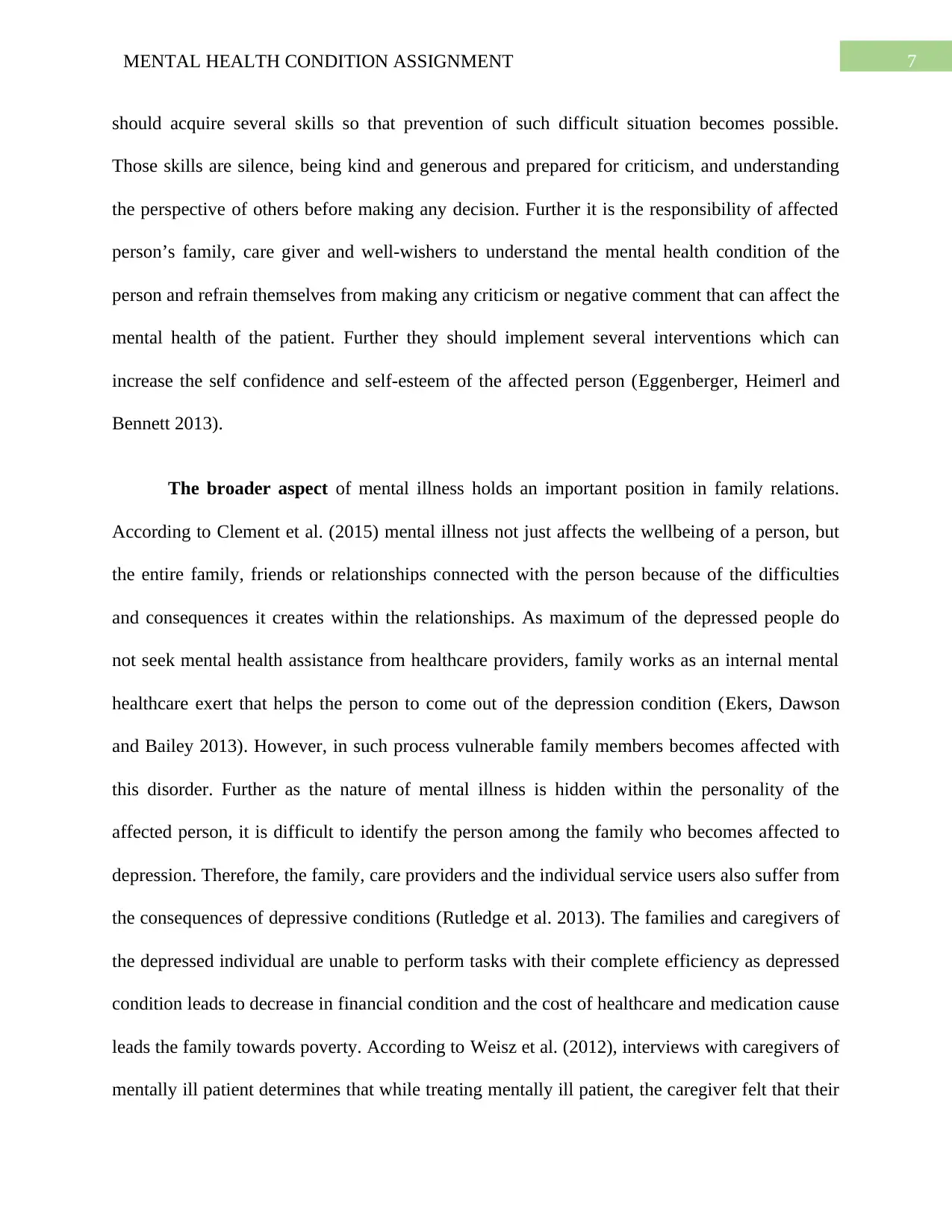
7MENTAL HEALTH CONDITION ASSIGNMENT
should acquire several skills so that prevention of such difficult situation becomes possible.
Those skills are silence, being kind and generous and prepared for criticism, and understanding
the perspective of others before making any decision. Further it is the responsibility of affected
person’s family, care giver and well-wishers to understand the mental health condition of the
person and refrain themselves from making any criticism or negative comment that can affect the
mental health of the patient. Further they should implement several interventions which can
increase the self confidence and self-esteem of the affected person (Eggenberger, Heimerl and
Bennett 2013).
The broader aspect of mental illness holds an important position in family relations.
According to Clement et al. (2015) mental illness not just affects the wellbeing of a person, but
the entire family, friends or relationships connected with the person because of the difficulties
and consequences it creates within the relationships. As maximum of the depressed people do
not seek mental health assistance from healthcare providers, family works as an internal mental
healthcare exert that helps the person to come out of the depression condition (Ekers, Dawson
and Bailey 2013). However, in such process vulnerable family members becomes affected with
this disorder. Further as the nature of mental illness is hidden within the personality of the
affected person, it is difficult to identify the person among the family who becomes affected to
depression. Therefore, the family, care providers and the individual service users also suffer from
the consequences of depressive conditions (Rutledge et al. 2013). The families and caregivers of
the depressed individual are unable to perform tasks with their complete efficiency as depressed
condition leads to decrease in financial condition and the cost of healthcare and medication cause
leads the family towards poverty. According to Weisz et al. (2012), interviews with caregivers of
mentally ill patient determines that while treating mentally ill patient, the caregiver felt that their
should acquire several skills so that prevention of such difficult situation becomes possible.
Those skills are silence, being kind and generous and prepared for criticism, and understanding
the perspective of others before making any decision. Further it is the responsibility of affected
person’s family, care giver and well-wishers to understand the mental health condition of the
person and refrain themselves from making any criticism or negative comment that can affect the
mental health of the patient. Further they should implement several interventions which can
increase the self confidence and self-esteem of the affected person (Eggenberger, Heimerl and
Bennett 2013).
The broader aspect of mental illness holds an important position in family relations.
According to Clement et al. (2015) mental illness not just affects the wellbeing of a person, but
the entire family, friends or relationships connected with the person because of the difficulties
and consequences it creates within the relationships. As maximum of the depressed people do
not seek mental health assistance from healthcare providers, family works as an internal mental
healthcare exert that helps the person to come out of the depression condition (Ekers, Dawson
and Bailey 2013). However, in such process vulnerable family members becomes affected with
this disorder. Further as the nature of mental illness is hidden within the personality of the
affected person, it is difficult to identify the person among the family who becomes affected to
depression. Therefore, the family, care providers and the individual service users also suffer from
the consequences of depressive conditions (Rutledge et al. 2013). The families and caregivers of
the depressed individual are unable to perform tasks with their complete efficiency as depressed
condition leads to decrease in financial condition and the cost of healthcare and medication cause
leads the family towards poverty. According to Weisz et al. (2012), interviews with caregivers of
mentally ill patient determines that while treating mentally ill patient, the caregiver felt that their
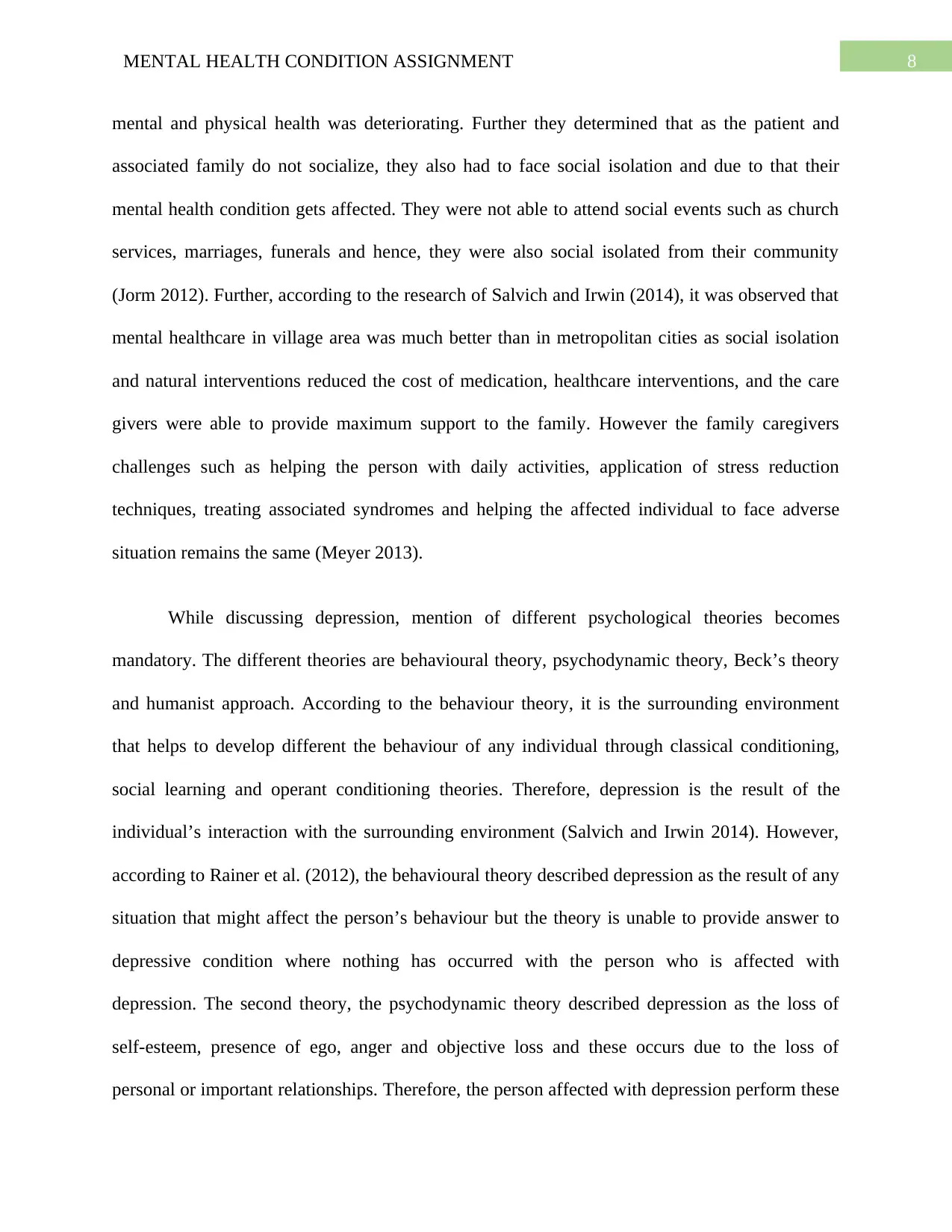
8MENTAL HEALTH CONDITION ASSIGNMENT
mental and physical health was deteriorating. Further they determined that as the patient and
associated family do not socialize, they also had to face social isolation and due to that their
mental health condition gets affected. They were not able to attend social events such as church
services, marriages, funerals and hence, they were also social isolated from their community
(Jorm 2012). Further, according to the research of Salvich and Irwin (2014), it was observed that
mental healthcare in village area was much better than in metropolitan cities as social isolation
and natural interventions reduced the cost of medication, healthcare interventions, and the care
givers were able to provide maximum support to the family. However the family caregivers
challenges such as helping the person with daily activities, application of stress reduction
techniques, treating associated syndromes and helping the affected individual to face adverse
situation remains the same (Meyer 2013).
While discussing depression, mention of different psychological theories becomes
mandatory. The different theories are behavioural theory, psychodynamic theory, Beck’s theory
and humanist approach. According to the behaviour theory, it is the surrounding environment
that helps to develop different the behaviour of any individual through classical conditioning,
social learning and operant conditioning theories. Therefore, depression is the result of the
individual’s interaction with the surrounding environment (Salvich and Irwin 2014). However,
according to Rainer et al. (2012), the behavioural theory described depression as the result of any
situation that might affect the person’s behaviour but the theory is unable to provide answer to
depressive condition where nothing has occurred with the person who is affected with
depression. The second theory, the psychodynamic theory described depression as the loss of
self-esteem, presence of ego, anger and objective loss and these occurs due to the loss of
personal or important relationships. Therefore, the person affected with depression perform these
mental and physical health was deteriorating. Further they determined that as the patient and
associated family do not socialize, they also had to face social isolation and due to that their
mental health condition gets affected. They were not able to attend social events such as church
services, marriages, funerals and hence, they were also social isolated from their community
(Jorm 2012). Further, according to the research of Salvich and Irwin (2014), it was observed that
mental healthcare in village area was much better than in metropolitan cities as social isolation
and natural interventions reduced the cost of medication, healthcare interventions, and the care
givers were able to provide maximum support to the family. However the family caregivers
challenges such as helping the person with daily activities, application of stress reduction
techniques, treating associated syndromes and helping the affected individual to face adverse
situation remains the same (Meyer 2013).
While discussing depression, mention of different psychological theories becomes
mandatory. The different theories are behavioural theory, psychodynamic theory, Beck’s theory
and humanist approach. According to the behaviour theory, it is the surrounding environment
that helps to develop different the behaviour of any individual through classical conditioning,
social learning and operant conditioning theories. Therefore, depression is the result of the
individual’s interaction with the surrounding environment (Salvich and Irwin 2014). However,
according to Rainer et al. (2012), the behavioural theory described depression as the result of any
situation that might affect the person’s behaviour but the theory is unable to provide answer to
depressive condition where nothing has occurred with the person who is affected with
depression. The second theory, the psychodynamic theory described depression as the loss of
self-esteem, presence of ego, anger and objective loss and these occurs due to the loss of
personal or important relationships. Therefore, the person affected with depression perform these
⊘ This is a preview!⊘
Do you want full access?
Subscribe today to unlock all pages.

Trusted by 1+ million students worldwide
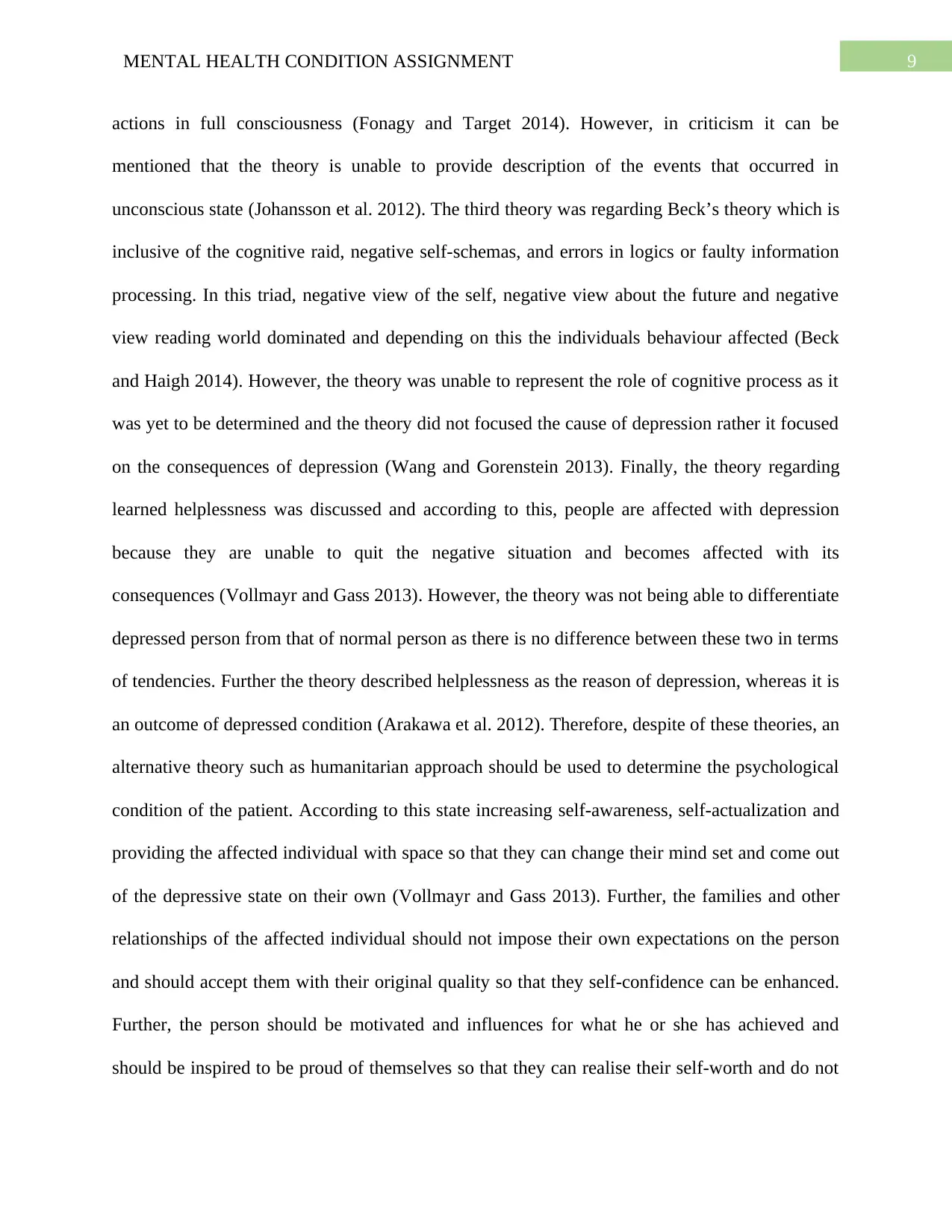
9MENTAL HEALTH CONDITION ASSIGNMENT
actions in full consciousness (Fonagy and Target 2014). However, in criticism it can be
mentioned that the theory is unable to provide description of the events that occurred in
unconscious state (Johansson et al. 2012). The third theory was regarding Beck’s theory which is
inclusive of the cognitive raid, negative self-schemas, and errors in logics or faulty information
processing. In this triad, negative view of the self, negative view about the future and negative
view reading world dominated and depending on this the individuals behaviour affected (Beck
and Haigh 2014). However, the theory was unable to represent the role of cognitive process as it
was yet to be determined and the theory did not focused the cause of depression rather it focused
on the consequences of depression (Wang and Gorenstein 2013). Finally, the theory regarding
learned helplessness was discussed and according to this, people are affected with depression
because they are unable to quit the negative situation and becomes affected with its
consequences (Vollmayr and Gass 2013). However, the theory was not being able to differentiate
depressed person from that of normal person as there is no difference between these two in terms
of tendencies. Further the theory described helplessness as the reason of depression, whereas it is
an outcome of depressed condition (Arakawa et al. 2012). Therefore, despite of these theories, an
alternative theory such as humanitarian approach should be used to determine the psychological
condition of the patient. According to this state increasing self-awareness, self-actualization and
providing the affected individual with space so that they can change their mind set and come out
of the depressive state on their own (Vollmayr and Gass 2013). Further, the families and other
relationships of the affected individual should not impose their own expectations on the person
and should accept them with their original quality so that they self-confidence can be enhanced.
Further, the person should be motivated and influences for what he or she has achieved and
should be inspired to be proud of themselves so that they can realise their self-worth and do not
actions in full consciousness (Fonagy and Target 2014). However, in criticism it can be
mentioned that the theory is unable to provide description of the events that occurred in
unconscious state (Johansson et al. 2012). The third theory was regarding Beck’s theory which is
inclusive of the cognitive raid, negative self-schemas, and errors in logics or faulty information
processing. In this triad, negative view of the self, negative view about the future and negative
view reading world dominated and depending on this the individuals behaviour affected (Beck
and Haigh 2014). However, the theory was unable to represent the role of cognitive process as it
was yet to be determined and the theory did not focused the cause of depression rather it focused
on the consequences of depression (Wang and Gorenstein 2013). Finally, the theory regarding
learned helplessness was discussed and according to this, people are affected with depression
because they are unable to quit the negative situation and becomes affected with its
consequences (Vollmayr and Gass 2013). However, the theory was not being able to differentiate
depressed person from that of normal person as there is no difference between these two in terms
of tendencies. Further the theory described helplessness as the reason of depression, whereas it is
an outcome of depressed condition (Arakawa et al. 2012). Therefore, despite of these theories, an
alternative theory such as humanitarian approach should be used to determine the psychological
condition of the patient. According to this state increasing self-awareness, self-actualization and
providing the affected individual with space so that they can change their mind set and come out
of the depressive state on their own (Vollmayr and Gass 2013). Further, the families and other
relationships of the affected individual should not impose their own expectations on the person
and should accept them with their original quality so that they self-confidence can be enhanced.
Further, the person should be motivated and influences for what he or she has achieved and
should be inspired to be proud of themselves so that they can realise their self-worth and do not
Paraphrase This Document
Need a fresh take? Get an instant paraphrase of this document with our AI Paraphraser
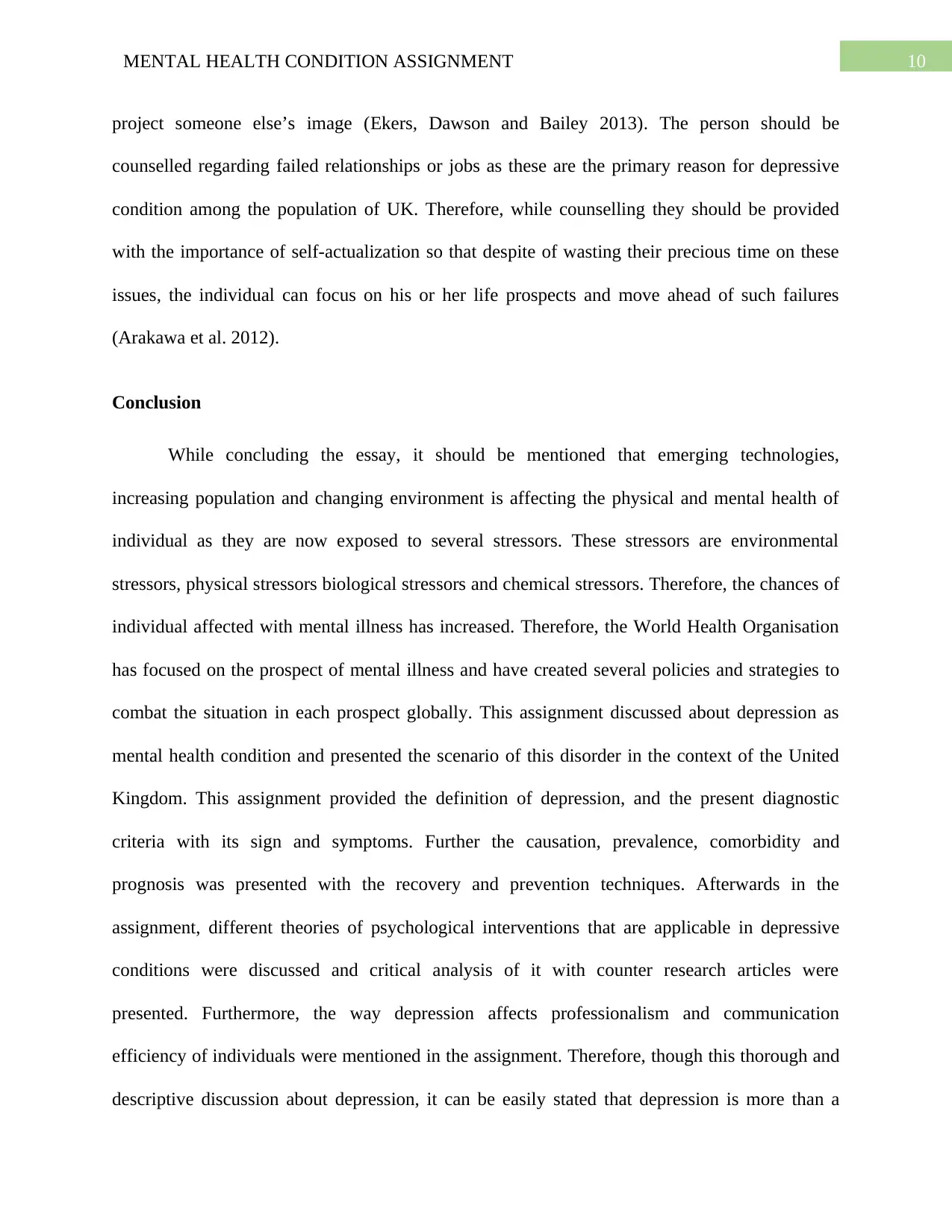
10MENTAL HEALTH CONDITION ASSIGNMENT
project someone else’s image (Ekers, Dawson and Bailey 2013). The person should be
counselled regarding failed relationships or jobs as these are the primary reason for depressive
condition among the population of UK. Therefore, while counselling they should be provided
with the importance of self-actualization so that despite of wasting their precious time on these
issues, the individual can focus on his or her life prospects and move ahead of such failures
(Arakawa et al. 2012).
Conclusion
While concluding the essay, it should be mentioned that emerging technologies,
increasing population and changing environment is affecting the physical and mental health of
individual as they are now exposed to several stressors. These stressors are environmental
stressors, physical stressors biological stressors and chemical stressors. Therefore, the chances of
individual affected with mental illness has increased. Therefore, the World Health Organisation
has focused on the prospect of mental illness and have created several policies and strategies to
combat the situation in each prospect globally. This assignment discussed about depression as
mental health condition and presented the scenario of this disorder in the context of the United
Kingdom. This assignment provided the definition of depression, and the present diagnostic
criteria with its sign and symptoms. Further the causation, prevalence, comorbidity and
prognosis was presented with the recovery and prevention techniques. Afterwards in the
assignment, different theories of psychological interventions that are applicable in depressive
conditions were discussed and critical analysis of it with counter research articles were
presented. Furthermore, the way depression affects professionalism and communication
efficiency of individuals were mentioned in the assignment. Therefore, though this thorough and
descriptive discussion about depression, it can be easily stated that depression is more than a
project someone else’s image (Ekers, Dawson and Bailey 2013). The person should be
counselled regarding failed relationships or jobs as these are the primary reason for depressive
condition among the population of UK. Therefore, while counselling they should be provided
with the importance of self-actualization so that despite of wasting their precious time on these
issues, the individual can focus on his or her life prospects and move ahead of such failures
(Arakawa et al. 2012).
Conclusion
While concluding the essay, it should be mentioned that emerging technologies,
increasing population and changing environment is affecting the physical and mental health of
individual as they are now exposed to several stressors. These stressors are environmental
stressors, physical stressors biological stressors and chemical stressors. Therefore, the chances of
individual affected with mental illness has increased. Therefore, the World Health Organisation
has focused on the prospect of mental illness and have created several policies and strategies to
combat the situation in each prospect globally. This assignment discussed about depression as
mental health condition and presented the scenario of this disorder in the context of the United
Kingdom. This assignment provided the definition of depression, and the present diagnostic
criteria with its sign and symptoms. Further the causation, prevalence, comorbidity and
prognosis was presented with the recovery and prevention techniques. Afterwards in the
assignment, different theories of psychological interventions that are applicable in depressive
conditions were discussed and critical analysis of it with counter research articles were
presented. Furthermore, the way depression affects professionalism and communication
efficiency of individuals were mentioned in the assignment. Therefore, though this thorough and
descriptive discussion about depression, it can be easily stated that depression is more than a
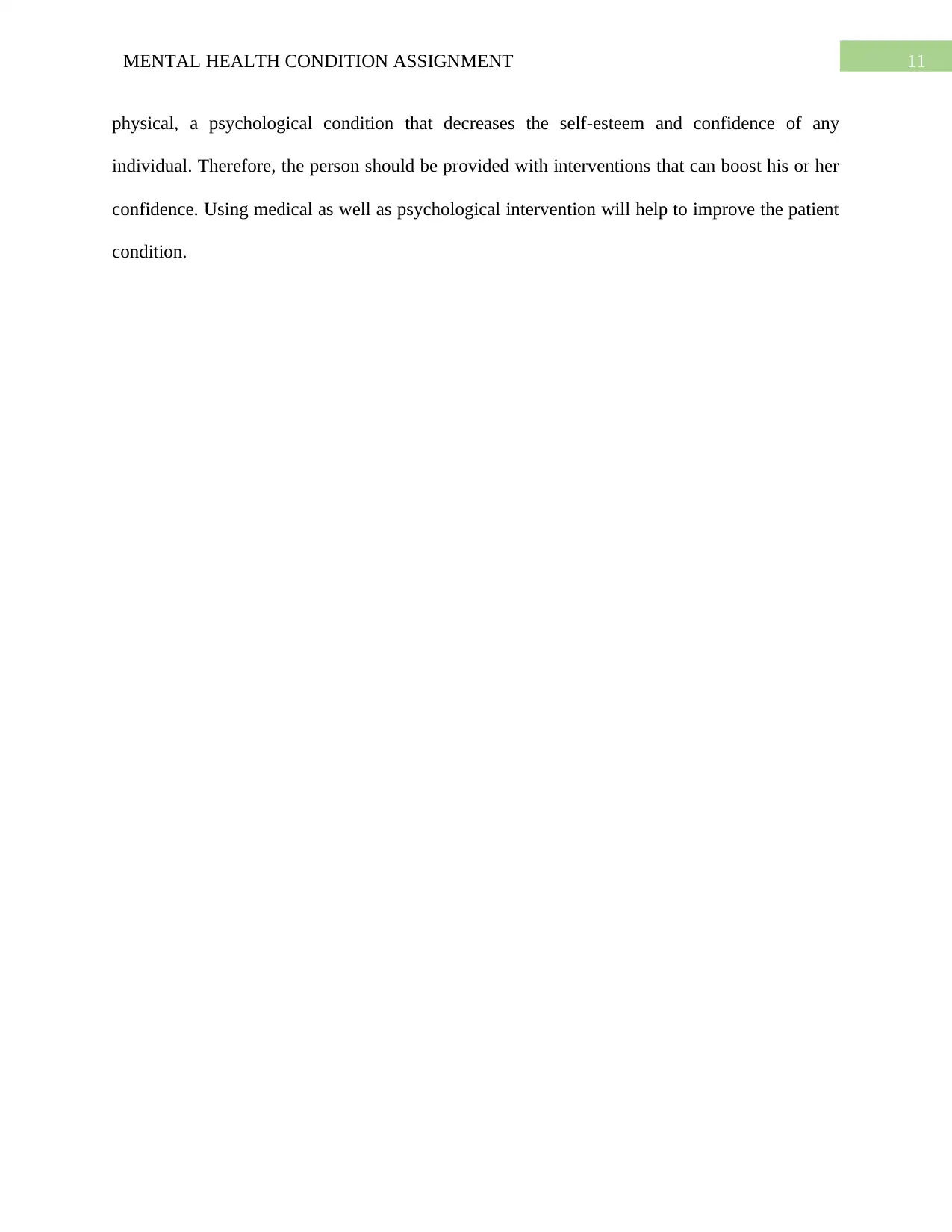
11MENTAL HEALTH CONDITION ASSIGNMENT
physical, a psychological condition that decreases the self-esteem and confidence of any
individual. Therefore, the person should be provided with interventions that can boost his or her
confidence. Using medical as well as psychological intervention will help to improve the patient
condition.
physical, a psychological condition that decreases the self-esteem and confidence of any
individual. Therefore, the person should be provided with interventions that can boost his or her
confidence. Using medical as well as psychological intervention will help to improve the patient
condition.
⊘ This is a preview!⊘
Do you want full access?
Subscribe today to unlock all pages.

Trusted by 1+ million students worldwide
1 out of 17
Related Documents
Your All-in-One AI-Powered Toolkit for Academic Success.
+13062052269
info@desklib.com
Available 24*7 on WhatsApp / Email
![[object Object]](/_next/static/media/star-bottom.7253800d.svg)
Unlock your academic potential
Copyright © 2020–2025 A2Z Services. All Rights Reserved. Developed and managed by ZUCOL.





